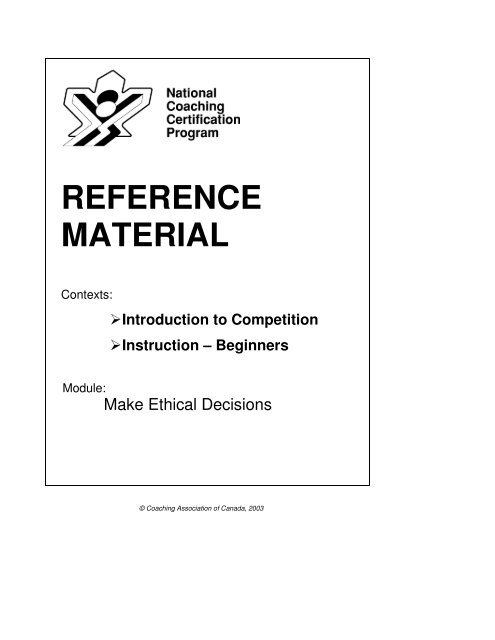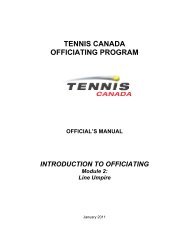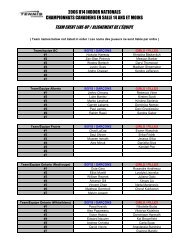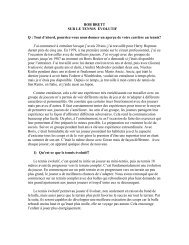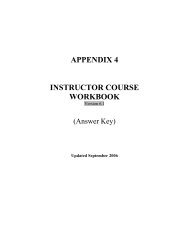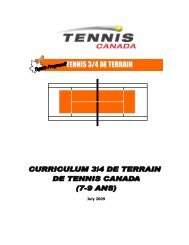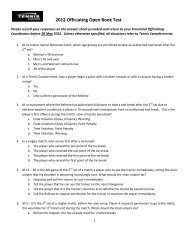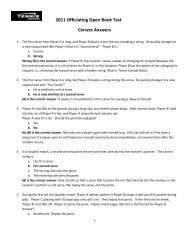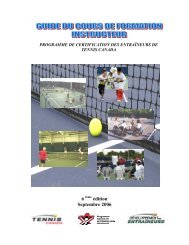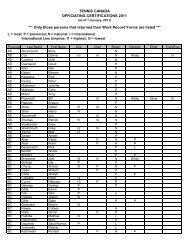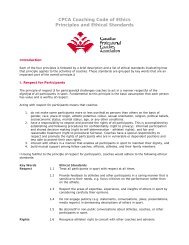Making Ethical Decisions - Tennis Canada
Making Ethical Decisions - Tennis Canada
Making Ethical Decisions - Tennis Canada
Create successful ePaper yourself
Turn your PDF publications into a flip-book with our unique Google optimized e-Paper software.
A Registry of GI Motility Laboratories for Patient EvaluationCompiled and Maintained by The American Neurogastroenterology and Motility Society (ANMS)Location Name Physician(s) in Charge Contact Info Technician/Nurse Procedures Performed 3EM EpH EGG ADM ARM BHTUNITED STATES OF AMERICAArizonaPhoenix St. Joseph’s Hospital & Medical Center Ross Bremner 602-406-6488 Mary Lou Dinoffria Yes Yes No No No No602-406-6770Scottsdale Mayo Clinic Scottsdale Michael Crowell 480-301-6990 Jeannie Stoa Yes Yes Yes Yes Yes YesJohn DiBaise crowel.michael@mayo.edu480-301-6990Tucson University of Arizona Ronnie Fass 520-792-1450 Jeannette Powers Yes Yes No No Yes Nofass@u.arizona.edu 520-792-1450 x5547CaliforniaBurbank Providence St. Joseph Medical Center Rimma Shaposhnikov 8182956944 Dosie McLean Yes Yes No No No Norimma18@yahoo.com f8182956948 8188476999Loma Linda Loma Linda University Medical Center Terence D. Lewis 909-558-4905 Harlan Larsen Yes Yes No No Yes Notlewis@ahs.liumc.edu 909-558-4668Los Angeles Cedars-Sinai Medical Center Mark Pimentel 310-423-6143 Tess Constantino Yes Yes No Yes Yes YesJeffrey Conklin pimentelm@cshs.org 310-423-6143Los Angeles University of California – Los Angeles Lin Chang 310-312-9276 Deborah Sable Yes Yes Yes Yes Yes Yeslinchang@ucla.edu 310-794-6380Mountain View El Camino GI Medical Associates George Triadafilopoulos 650-988-7488 Jennifer Vassale Yes Yes Yes Yes Yes Yesvagt@stanford.edu 650-988-7488Orange University of California – Irvine Hooshang Meshkinpour 714-456-6745 Mary Highland Yes Yes No No Yes Yeshmishkin@uci,edu 714-456-7636Sacramento University of California, Davis Juan Carlos Garcia 916-734-5561 Connie Wigen Yes Yes No No Yes YesAmar Al-Juburi juan.garica@ucdmc.ucdavis.eduSan Diego University of California San Diego Ravinder Mittal 858-552-7556 Debbie den Boer Yes Yes No No Yes Yesrmittal@ucsd.edu 619-543-6834San Francisco California Pacific Medical Center William J. Snape, Jr 415-600-1138 Tina Berg Yes Yes Yes Yes Yes YesSnapew@sutterhealth.org415-600-1138ConnecticutNew Haven Yale University School of Medicine Anish Sheth 203-785-4138 Peggy Kramer Yes Yes Yes No Yes YesAnish.sheth@yale.edu 203-785-4138FloridaCoral Springs Digestive Care David Silver 954-755-7991 Nora Spitzer Yes Yes No No Yes Yesdsilverm1@digestivecareonline.com 954-755-7991
The National Coaching Certification Program is a collaborative program of theGovernment of <strong>Canada</strong>, provincial/territorial governments, national/provincial/territorialsport federations, and the Coaching Association of <strong>Canada</strong>.Partners in Coach EducationThe programs of this organization are funded in part by Sport <strong>Canada</strong>.Printed in <strong>Canada</strong>© Coaching Association of <strong>Canada</strong>, 2003
Unless otherwise indicated, images and pictures contained in this document are theproperty of HEMERA TECHNOLOGIES INC. They are used under license and arecopyrighted.Some images contained in this document are the property of CARDISPORT and arecopyrighted.© This document is copyrighted by the Coaching Association of <strong>Canada</strong> (2003) and itslicensors. All rights reserved.© Coaching Association of <strong>Canada</strong>, 2003
© Coaching Association of <strong>Canada</strong>, 2003
© Coaching Association of <strong>Canada</strong>, 2003
Table of ContentsContentsPage1- An Introduction to Solving <strong>Ethical</strong> Situations 11.1- General Considerations 11.2- Values and Ethics: What Are They? 11.3- <strong>Ethical</strong> Decision-<strong>Making</strong> Process 2Analysis and Decision-<strong>Making</strong> Process for Situations That Have <strong>Ethical</strong>3Implications2- <strong>Ethical</strong> Decision-<strong>Making</strong> Process 4Step 1 - Establish the Facts of the Situation 4Step 2 - Determine What are the Issues in the Situation: (a) Does the5Situation Have Legal Implications?Examples of Situations That Have Legal Implications 5Actions to Take in Situations That Have Legal Implications 6Critical Path: Determining if a Situation is Legal 7Step 2 - Determine What are the Issues in the Situation: (b) Does the8Situation Have <strong>Ethical</strong> Implications?Situations That Have <strong>Ethical</strong> Implications 8When Can a Coach Know that a Situation has <strong>Ethical</strong> Implications? 8Step 3 - Identify Potential <strong>Decisions</strong> That Could Be Made or Actions9Undertaken, and Consider What Might Result in Each CaseNCCP Code of Ethics 10Fair Play Principles 14Step 4 - Identify the Pros and Cons of Each Potential Decision That Could 14Be MadeStep 5 - Select the Best Option for the Decision 16<strong>Making</strong> <strong>Decisions</strong> That Are “Just and Reasonable” 16Factors That Can Influence Decision-<strong>Making</strong> 17Moral Dilemmas and <strong>Ethical</strong> Decision-<strong>Making</strong> 20Questions to Help You Prioritize Principles and Values When Faced With an 21<strong>Ethical</strong> DilemmaQuestions That May Help You to Validate That Your Decision is “Just and 22Reasonable”Step 6 - Design an Action Plan to Implement the Selected Decision, and Plan 23to Manage its ConsequencesGeneral Coaching Tips 24References 25Acknowledgements 26Appendix 1 – Sample Code of Conduct for Athletes 27Appendix 2 – Sample Code of Conduct for Parents 28Appendix 3 – Sport as a Discrimination-Free Zone 29© Coaching Association of <strong>Canada</strong>, 2003
1- An Introduction to Solving <strong>Ethical</strong> Situations1.1- General ConsiderationsAs a coach, you will deal with a wide range of issues. Depending on the type ofissue with which you are faced, you may experience a variety of emotions/feelings andthoughts.Sometimes, you may feel that an action/behaviour is wrong. At other times, youmay suspect or even know that a behaviour is illegal. In other instances, you may feelunsure about a situation and a decision, since there seems to be a number ofalternatives that could be acceptable. If you ask yourself this type of question, the issuemost likely has ethical implications.Often, a conversation with the person(s) involved is all that is necessary toadequately deal with the situation. However, at other times this will not be sufficient, andyou may have to make a more formal intervention or refer the matter to some other levelof authority.1.2- Values and Ethics: What Are They?Our values represent a set of deeply held beliefs upon which our thoughts andactions are based; we refer to our values in evaluating our own actions as well as theactions and decisions of others. In coaching, our core values are expressed as a seriesof principles defined by the NCCP Code of Ethics. A code of ethics defines what isconsidered good and right behaviour.<strong>Ethical</strong> issues arise when our values and the corresponding ethical principles arecompromised in some way. When this happens, the decisions are often sensitive anddifficult to make. In these situations, the quality of the decisions made by the coachdepends on a number of factors including: an understanding of the facts of the situation an awareness of his/her own values, and of the various factors that caninfluence his/her decision the use of appropriate benchmarks to analyze the situation and understandwhat is involved the ability to apply a rigorous decision-making framework to the situation athandThis module deals with each of these factors as part of an ethical decision-makingprocess.© Coaching Association of <strong>Canada</strong>, 2003 1
1.3- <strong>Ethical</strong> Decision-<strong>Making</strong> ProcessThis document outlines a process that will enable you to make thoughtful and responsibledecisions in situations presenting ethical or moral dilemmas. To this end, a series of stepswill be proposed, each emphasizing certain questions. These steps are summarized inthe diagram on the following page.If you follow this path and answer the questions to the best of your knowledge, you will:(1) ensure you have a thorough process to enable you to make sensitive decisions;(2) have solid arguments to justify your decisions from an ethical point of view; and(3) feel confident to fully assume the consequences of your decisions, knowing that “itwas the right thing to do under the circumstances”.Note: The process described in the following sections applies to situations that do notrequire an emergency response by the coach. In the case of crucial and urgent situations,for instance when a person is injured or if there is an imminent risk for the safety ofpeople, the duty of the coach is to take whatever measures he/she feels are necessary inthe short term to manage the situation, and to protect the individuals concerned. Theseparticular aspects are dealt with in the “Planning a practice” module, in sections of theReference Material that cover risk factors, emergency action plan, and coach liability.© Coaching Association of <strong>Canada</strong>, 2003 2
Analysis and Decision-<strong>Making</strong> Processfor Situations That Have <strong>Ethical</strong> ImplicationsEstablish thefacts of thesituationOnce you know thefacts, determine whatare the issues- Is this a situation that has legalimplications?- If the situation has no legal implications,what ethical issues might be involved?Have allthe factsbeenidentified?Consider potentialoptions for action ordecision, and theirpotential consequencesAssess the pros andcons of each optionHow does each optionlead to a fair decisionwith regard to the:- outcomes or results- means used toachieve resultsSelect the best option- Have I thought aboutfactors that might influencemy decision?- What values must bepreserved in the situation?- Is this a just andreasonable decision?Implement the decision andmanage the consequencesWhat is the best courseof action to follow? Whoshould be involved?© Coaching Association of <strong>Canada</strong>, 2003 3
2- <strong>Ethical</strong> Decision-<strong>Making</strong> ProcessStep 1 - Establish the Facts of the SituationWhen faced with any situation or problem in coaching, your first task is to establishexactly what has happened (or is happening) and who is involved in the situation beforetrying to figure out what you will do about it.At this stage, ask yourself the following questions:• What has happened or what is happening? When and where did certain eventsoccur? Get the facts from all the parties involved, and look at the situation fromboth sides if there is disagreement or conflict.• Who is (or might be) involved in or concerned by the situation?• What do the parties involved have to say about the situation (i.e. what are allsides of the story)?© Coaching Association of <strong>Canada</strong>, 2003 4
Step 2 – Determine What are the Issues in the Situation:(a) Does the Situation Have Legal Implications?Once the facts have been clearly established, the next step consists in determiningwhether or not the situation has legal implications. Two useful questions to ask yourself atthis stage are:1. Has anyone been harmed by the action or decision of another, and if so, in what way?2. Does the action or the situation contravene an existing law?Examples of Situations That Have Legal Implications• Actions that are criminal or quasi-criminal - These are wide-ranging andcould include theft, assault, sexual assault, other sexual offenses, possession ofnarcotics, underage drinking, driving without a license or insurance, forgery,fraud, vandalism, etc.• Actions that breach a contract - These could include someone acting outsidethe scope of their delegated authority, violating agreed-upon rules relating to theuse of a facility or equipment, or failing to meet other contractual obligations.• Actions or information indicating there are reasonable grounds to believe thata child may be in need of protection.• Actions that are discriminatory - Actions of a government, organization orindividual that are contrary to the Canadian Charter of Rights and Freedoms, theCanadian Human Rights Act, or any provincial human rights legislation.• Actions that constitute harassment - Harassment is a form of discriminationand is contrary to human rights laws: in its extreme form, harassment may be acriminal offense.• Actions, even those that are not intentional, that could constitute negligence, aslegally defined.© Coaching Association of <strong>Canada</strong>, 2003 5
Actions to Take in Situations That Have Legal ImplicationsA coach occupies a position of authority and, accordingly, has important legalresponsibilities. When a coach is confronted by a legal situation such as thosedescribed on the previous page, he/she has a duty to do something about it.This would involve:• Reporting the situation to the police, where the coach is aware of orreasonably suspects criminal or quasi-criminal activity.• Reporting the situation to child protection authorities, where a coachsuspects that a child has suffered physical or emotional harm, or is incircumstances where a risk of such harm exists.• Reporting the matter to the employer or to the organization having authorityover the persons involved in the conduct, for all other legal matters.© Coaching Association of <strong>Canada</strong>, 2003 6
Critical Path:Determining if a Situation is LegalDetermine the Facts of the SituationBased on the facts, determine if the situation is legal. It willautomatically be so if it relates to one or more of the elements below:• Actions that are criminal or quasi-criminal - These are wide-ranging and couldinclude theft, assault, sexual assault, other sexual offenses, possession ofnarcotics, underage drinking, driving without a license or insurance, forgery, fraud,vandalism, etc.• Actions that breach a contract - These could include someone acting outside thescope of their delegated authority, violating agreed-upon rules relating to the useof a facility or equipments, or failing to meet other contractual obligations.• Actions or information indicating there are reasonable grounds to believe that achild may be in need of protection.• Actions that are discriminatory - Actions of a government, organization orindividual that are contrary to the Canadian Charter of Rights and Freedoms, theCanadian Human Rights Act, or any provincial human rights legislation.• Actions that constitute harassment - Harassment is a form of discrimination andis contrary to human rights laws: in its extreme form, harassment may be a criminaloffense.• Actions, even those that are not intentional, that could constitute negligence, aslegally defined.YESActions to takeInform appropriateauthority:NOUse the ethicaldecision-makingprocess• Police• Child protectionservice• Employer• Other© Coaching Association of <strong>Canada</strong>, 2003 7
Step 2 – Determine What are the Issues in the Situation:(b) Does the Situation Have <strong>Ethical</strong> Implications?Situations That Have <strong>Ethical</strong> ImplicationsLaw and ethics are related and overlap, but they are not identical. Conduct that is illegalis always unethical. Yet, some forms of conduct may be unethical even though they are legal.The law therefore represents an absolute minimum standard of behaviour, while the standardfor ethical behaviour is somewhat higher.When the coach encounters a situation that does not violate any law but nonethelessraises moral questions, he/she must make decisions about how how best to respond. Underthese circumstances, ethical principles are often called upon.When Can a Coach Know that a Situation has <strong>Ethical</strong> Implications?<strong>Ethical</strong> conduct can be described as a behaviour that meets accepted standards orprinciples of moral, professional or just conduct. Unethical behaviour is the contrary, i.e. actionsor decisions that are immoral, unprofessional or unjust.Once you have determined that the situation is not of a legal nature, it is important todetermine whether it presents an ethical issue. At this stage, ask yourself the following question:Given the facts that have been identified, is there a reasonable doubt that the situationmight impact on, or be related to, one or more of the following?:Safety of one or more individualsShort or long term well-being or health of one or more individualsRespect for established principles, rules (rules of the team, the game, etc.), orpolicies of an organizationObligations, loyalties, word given, prior commitments made, responsibilities of theperson(s) concernedAppropriate use of power by the individuals in a position of authorityObjectives and goals sought by the group or by an individualBehaviours or practices that are generally considered acceptable, or that areexpected under the circumstances at hand (standard of behaviour)Fairness and equity; using acceptable means; respect of othersConfidentiality of information and privacy; appropriate use of informationAt this stage, any statement from the above list that you have checked should cause you tobelieve that there are one or more ethical issues in the situation.© Coaching Association of <strong>Canada</strong>, 2003 8
Step 3 - Identify Potential <strong>Decisions</strong> That Could Be Made orActions Undertaken, and Consider What Might Result inEach CaseBecause they often relate to sensitive issues, ethical situations may generate some degree ofemotional reaction. As a result, some individuals may have a tendency to react quickly andspontaneously, and to make quick decisions. Sometimes, this may affect their judgment and thequality of the decisions they make.Having determined that the situation does have some ethical implications and identified somepotential ethical issues (based on the statements listed in the previous step), you should nowidentify options for decision or for action, and assess potential consequences in each case. Thisreflection represents an important step in the ethical decision-making process because it showsthat you care about what might happen to others.Start by asking yourself: “What could I do in this situation?” In the process of answering thisquestion, think about a variety of options. The first one to consider should be “not making anydecision” or “taking no action”. This would be the least demanding option, and it could bethought of as representing one end of a continuum of possibilities. As a second step, considerthe other “extreme” of the continuum, and think of the most comprehensive or liberal action youmight take in the situation. Then, identify several intermediate options. Do not rule out anyoption at this stage, even though at the outset it may appear an unlikely choice.Continuum of Options for Decision or for ActionDo nothing ormake no decisionIntermediateoptionsMost comprehensive orliberal action or decisionthat can be madeOnce several options for decision have been identified, think about “What might happen if …”.This will enable you to assess potential consequences that may result from each option. Inmany ethical situations where a “Yes – No” decision must be made, the following questions arelikely to arise:• What might happen if the coach chose not to make any decision or took no action?• What might happen if the coach’s position were favorable to the situation, question, orissue at hand?• What might happen if the coach’s position were not favorable to the situation, question,or issue at hand?© Coaching Association of <strong>Canada</strong>, 2003 9
NCCP Code of Ethics© Coaching Association of <strong>Canada</strong>, 2003 10
NCCP Code of EthicsWhat is a Code of Ethics?A code of ethics defines what is considered good and right behaviour. It reflects thevalues held by a group, and outlines the expected conduct of members while theyperform their duties. It can also be used as a benchmark to assess whether certainbehaviours are acceptable.Why a Code of Ethics in Coaching?Core coaching values have been formalized and expressed as a series of principles inthe NCCP Code of Ethics. These principles can be thought of as a set of duties andresponsibilities regarding participation in sport, coaching athletes or teams, andadministering sports.The NCCP Code of Ethics can help coaches to evaluate issues arising within sportbecause it represents a reference for what constitutes “the right thing to do”.Principles of the NCCP Code of EthicsThe NCCP Code of Ethics is a simplified version of the Code of Ethics of the CanadianProfessional Coaches Association (CPCA). However, both codes deal with the samefundamental principles and beliefs:1. Respect for Athletes2. Coaching Responsibly3. Maintaining Integrity in Relations with Others4. Honouring SportThe following pages provide a description of each principle and outline implications forcoaches.The Fair Play principles, which follow the NCCP Code of Ethics, relate to the principle of“Honouring Sport”.© Coaching Association of <strong>Canada</strong>, 2003 11
.NCCP Code of Ethics1. Respect for AthletesThe principle of respect for athletes challenges coaches to act in a manner respectful of thedignity of those involved in sport. This principle is based on the basic assumption that eachperson has value and is worthy of respect. Acting with respect for participants means thatcoaches:• Do not make some participants feel more or less worthy as persons than others, onthe basis of gender, race, place of origin, athletic potential, colour, sexual orientation,religion, political beliefs, socio-economic status, marital status, age, or any otherconditions.• Have a responsibility to respect and promote the rights of all participants. This isaccomplished by establishing and following procedures for confidentiality (right toprivacy), informed participation and shared decision-making (right to selfdetermination– athletes’ rights), and fair and reasonable treatment (right toprocedural fairness). Coaches have a special responsibility to respect and promotethe rights of participants who are vulnerable or in dependent positions, and thereforeless able to protect their own rights.• Interact with others in a manner that enables all participants in sport to maintain theirdignity.• Build mutual support among fellow coaches, officials, athletes, and their familymembers.2. Coaching ResponsiblyThe principle of coaching responsibly carries the expectation that the activities of coacheswill benefit society in general, and athletes in particular, and will do no harm. Fundamentalto the implementation of this principle is the notion of competence, which implies thatcoaches should be well-prepared and possess up-to-date knowledge of their discipline sothat they will be able to maximize benefits and minimize risks to athletes.In addition, coaching responsibly implies that coaches:• Act in the best interest of the participant/athlete’s development as a whole person.• Recognize the power inherent in the position of coach.• Are aware of their personal values and how these affect their behaviour.• Acknowledge the limitations of their knowledge and competence in their sport.• Accept the responsibility to work with other coaches and professionals in sport in thebest interests of the athletes.© Coaching Association of <strong>Canada</strong>, 2003 12
Fair Play PrinciplesIn addition to a Code of Ethics, coaches and athletes should abide by theprinciples of Fair Play. Applying Fair Play principles implies that all those involved insport recognize the importance of fairness, a respectful attitude, and appropriateconduct when engaged in sporting activities, and agree to model and promote them.The following are examples of Fair Play behaviours for coaches, athletes, officials, andparents:• Follow all of the rules, and never seek to deliberately break a rule.• Aim to compete fairly, using talent and ability to win; refuse to win by illegalmeans or by cheating.• Respect the official(s), and accept their decisions without doubting their integrity.• Recognize good performances by the opponent.• Maintain dignity in all circumstances, and demonstrate self-control. In defeat,recognize with dignity the superiority of the opponent. In victory, act modestly,and do not ridicule the opponent.• For the officials – know all the rules well, and apply them with impartiality at alltimes.Note: The Fair Play principles, the NCCP Code of Ethics, and the sample codes ofconduct for parents and athletes found in the appendix can all serve as starting points tohelp in the creation of a team code of conduct that is designed and agreed upon by theathletes, parents and other coaches of your team.© Coaching Association of <strong>Canada</strong>, 2003 14
Step 5 – Select the Best Option for the Decision<strong>Making</strong> <strong>Decisions</strong> That Are “Just and Reasonable”We are now reaching a crucial phase of our process, i.e. the one where a decision mustbe made. At this stage, it is important to bring together key elements of the previoussteps and reflect on how to make “the best possible decision under the circumstances”.In Step 4, we used certain criteria to assess the merit of a variety of options for decisionor for action. Based on these criteria, a solution that is “just and reasonable” cantherefore be defined as one that:1. Results in a positive outcome for the majority of the individuals concerned.2. Minimizes the negative implications for all parties involved.3. Appears to be the “right thing to do” with regard to your coaching duties andresponsibilities.4. Is being made using a fair and equitable process.5. Is consistent with certain expected standards of behaviour, such as thoseoutlined in the NCCP Code of Ethics.However, despite the availability of such criteria, not all ethical decisions are clear-cut.In some instances, a coach may experience some difficulty in making a decisionbecause there appears to be more than one reasonable solution. Sometimes, makinga decision will even involve sacrificing one value for another. To rank options that seemreasonable with a view to “making the best possible decision”, we will now consider thefollowing aspects:1. What factors could possibly influence decision-making?2. How can one prioritize principles or values in which he/she strongly believes, butthat seem in conflict in the situation at hand? In other words, what do you dowhen you are confronted with an ethical dilemma?© Coaching Association of <strong>Canada</strong>, 2003 16
Factors That Can Influence Decision-<strong>Making</strong>The decisions we make can be influenced by many factors that we may or may not befully aware of. When taking a position or making a decision in a situation that has moralor ethical implications, it is important to ensure that we remain as objective as possible.Many of the previous steps were aimed at ensuring a high degree of objectivity. As youget closer to the making of your decision, it may be useful to consider certain factorsthat may influence you. This can help you to (1) become aware that certain factorsmight indeed be influencing you, and (2) assess to what degree they might drive youractions or decisions.For the purposes of our ethical decision-making process, we will consider two potentialsources of influence:(1) Internal factors(2) External factorsInternal Factors of InfluenceInternal influences are those that are intimately associated with the individual who isfaced with making the ethical decision.Personal Values• Have you experienced a similar situation before? If so, what did you do and howdid things turn out?• How would your family have viewed such a situation?• What did you learn from your education about the kind of situation you are nowfaced with?• How might spiritual or religious background/values impact on your evaluation ofthe issue?• How did you learn to view the situation at hand?• How might your level of experience impact on your ability to make an objectivedecision?© Coaching Association of <strong>Canada</strong>, 2003 17
Personal Circumstances• Does the decision have the potential to impact on your employment status?(Does your decision impact on someone who has an interest in the team but alsocontrols your employment status?)• How might your decision impact on the development of your coaching career?• How might your decision impact on your reputation in the club/sport/situation?(Will your decision alter peoples’ views of your coaching approach?)This does not appear tomake sense…External Factors of InfluenceExternal influences are those that arise from society, or from the environment in whichthe individual who is faced with making the decision lives.Economics and Politics• How might your decision impact on the economic situation of your team/club?(e.g., types of sponsorship – tobacco).• What are the political influences and/or ramifications of your decision? (genderissues)Severity of Situation• How immediate is the need to make a decision? (e.g., is the safety of anindividual at stake?)• Would delaying the decision be potentially harmful?• Who and how many people will be affected, and in what way?Organizational and Institutional• Do the values of the coach match those of the administration or the decisionmakersin the club setting?• Does the decision impact on others in other organizations and how will thedecision affect relationships?• Do the coach’s values match those of the community?• Does the coach have values that contrast with wider societal values?© Coaching Association of <strong>Canada</strong>, 2003 18
What Influences How You View a Situation andthe <strong>Decisions</strong> You Make?This figure has been adapted from Malloy, Ross, and Zackus, 2000Personal Experiences• Previous experience with asimilar issueInfluences internes• Positive or negative outcomesof previous similar decisionsPersonal Values• Family background/upbringing• Formal education• Religious beliefs• Age• Personal moral development• Cultural backgroundPersonal Circumstances• Employment• Coaching level anddevelopment• Reputation• Personal relationshipsInternal InfluencesDecision-<strong>Making</strong>External InfluencesEconomics and Politics• Economic impact of decisionon context• Political/rights-based issuesof the situationSeverity of Situation• Immediacy of the decision• Who is affected?• How many people areaffected?Organizational, Institutional,and Social Aspects• Relations and links with:• organizations• individuals• communities• Social norms and conventions• NCCP Code of Ethics© Coaching Association of <strong>Canada</strong>, 2003 19
Moral Dilemmas and <strong>Ethical</strong> Decision-<strong>Making</strong>As mentioned previously, certain ethical situations may generate strong feelings ordoubts because there seems to be more than one reasonable solution. Sometimes,making a decision even involves sacrificing one value for another. When there are twopotentially right solutions, such situations are referred to as ethical dilemmas – aconflict between values we wish to maintain.The challenge in ethical decision-making is to determine which valueyou will maintain in your course of action.Examples of possible conflicts between values, or ethical dilemmas, are providedbelow.Team Rules vs. Parental Rights and AuthorityA Team has a standing policy of curfew being set at 10:00 PM at away competitions.All parents give sign-off approval on this and other policies at the beginning of the year.One parent who often travels with the team routinely allows his/her son/daughter to stayup past this hour.Team Rules vs. Winning the CompetitionA Club has a strict policy of no swearing when on clubhouse grounds. The preestablishedpenalty for such speech is a one-competition automatic suspension. Theday before the championship competition, the leading athlete has a temper tantrumduring practice and mouths off using foul language to another athlete on the team.Duty to Do No Harm Principle vs. Athlete’s Will/Rights to PlayAn athlete has been experiencing chronic knee pain as a result of a growth spurt. Theathlete is begging you to be allowed to play in a key competition, and the parentssupport this athlete in his/her eagerness to play.© Coaching Association of <strong>Canada</strong>, 2003 20
Questions to Help You Prioritize Principles and Values When FacedWith an <strong>Ethical</strong> DilemmaSometimes, it is relatively easy to determine which value should take priority (e.g.,safety of athletes in your care) but in others, it is not as clear (e.g., amount of playingtime for each athlete).When someone is faced with an ethical or moral dilemma and is forced to choosebetween two values, it is normally his/her most deeply held beliefs that will dictate thecourse of action.Having thoroughly determined the pros and cons of the various options for decisionusing the criteria proposed in Step 4, and having reflected on some factors that mayinfluence your decision-making, you can resolve an ethical dilemma by asking yourselfthe following questions:• Which criteria (or value) do you consider the most important from those listed inStep 4?• What does the NCCP Code of Ethics suggest in this type of situation?• Is there another value in which you strongly believe, and that you would seek tomaintain at all costs? If so, which is it?Do No Harm PrincipleEven though it is a sensitive issue to suggest a ranking of your values, the NCCPnonetheless considers that, above all, it is the duty of all coaches to ensure thedecisions they make and the actions they take will result in no harm, physical orother, to the athletes.© Coaching Association of <strong>Canada</strong>, 2003 21
Questions That May Help You to Validate That Your Decision is “Justand Reasonable”Having gone through all the previous steps, you may still want to validate one more timethat your decision is really “just and reasonable”, by asking yourself the followingquestions:• Would you make this decision in all similar cases?• If you feel that you cannot apply your decision to all similar cases, what might be areasonable and justifiable exception? If so, in which circumstances? Do suchcircumstances apply in the present situation? What leads you to believe that anexception might be justified in this case, but not in other situations?• Is the decision consistent with previous decisions that have been made in similarsituations in the past, and that have resulted in a positive outcome?Going through this last series of questions should enable you to be confident that youhave made the best possible decision under the circumstances, and give you additionalarguments to fully assume the consequences that may unfold when the decision isannounced or implemented.© Coaching Association of <strong>Canada</strong>, 2003 22
Step 6 –Design an Action Plan to Implement the SelectedDecision, and Plan to Manage its ConsequencesIn Steps 1 to 5, you have been through a thorough reflection process that has made it possiblefor you to make a “just and reasonable decision” in response to an ethical situation. Thequestion now arises: “What to do next?”Putting your decision or plan of action into effect requires that you consider a number of things,particularly if it involves dealing with individuals or groups of people. Consider the followingquestions as you establish an action plan:Choose your path. Exactly what is it that you are going to do? Plan carefully the steps you aregoing to take.Think about what may happen. Consider the likely outcomes of the decision and how willthese consequences be managed?Identify who needs to know. Consider carefully who needs to be informed of, or involved in,the implementation of the action plan or decision.Determine if you can deal on your own with the person involved. Is it appropriate to seekan informal resolution in this situation? In issues not involving a contravention of the law, it isoften best to try and deal with the issue informally and directly with the individual involved. Weoften refer to this as adopting the conservative approach. It has the advantage of conferringresponsibility for actions upon the party involved and allows them to resolve the situation whilemaintaining their own sense of dignity and self-respect. It also establishes a degree of trustbetween parties involved. Approach the individual, and inform him/her of your observations orwhat has been shared with you. Give him/her a chance to respond, and a chance to do thegood or right thing.Warn, don’t threaten. This is an important concept when dealing with a situation at an informallevel. This entails informing the individual of the logical consequences of what can happen if asituation is not resolved, rather than threatening the person with an “end of run” right out of thegate! This is plan B. Keep plan B in your back pocket.Think about what you might do next if the informal resolution doesn’t work. In the eventan informal resolution does not work, carefully consider what to do next. Inform the individualthat you now have to follow up with “plan B”. Consider who should be contacted, and what levelof authority you should now involve in this situation.© Coaching Association of <strong>Canada</strong>, 2003 23
General Coaching TipsWhen in doubt or faced with an ethical dilemma, think about the “do no harm”principle.Never "second-guess" yourself on decisions made with integrity, intelligence,thoroughness, and based on accepted values.Make sure you are clear about your coaching values, and that you can talkabout them in a way that is clear, simple, and easily understood by everyone.Cross-reference your coaching values and principles with the NCCP Code ofEthics.Pay attention to what is important to kids in establishing your ethical standards.© Coaching Association of <strong>Canada</strong>, 2003 24
ReferencesCanadian Professional Coaches Association Code of Ethics, Ottawa, 1993.Malloy, D.C., Ross, S., & Zakus, D.H. Sport Ethics: Concepts and Cases in Sport andRecreation. Thompson Educational Publishing. 2000. ISBN 1-55077-107.Tomlinson, P., Strachan, D. : Power and Ethics in Coaching, Coaching Association of<strong>Canada</strong>, 128 pages, 1996.© Coaching Association of <strong>Canada</strong>, 2003 25
AcknowledgementsThe primary author of this document is Dr. Garry Wheeler, professor at the University ofAlberta and NCCP Master facilitator.The following individuals also contributed to this document:Guylaine Demers, Ph.D., Professor, Department of Physical Education of UniversitéLaval (Québec), and NCCP Master facilitator.Yvon Lachance, B.Sc. – NCCP Master facilitator.Alain Marion, M.Sc. – Director, National Coaching Certification Program (CoachingAssociation of <strong>Canada</strong>).AJ Woodburn, M.Sc. – Consultant, Coaching Association of <strong>Canada</strong>, NCCP Masterfacilitator.The Coaching Association of <strong>Canada</strong> also expresses its thanks to the Aboriginal SportCircle and to its executive director Rick Brant, to the Canadian Association for theAdvancement of Women and Sport and Physical Activity and its acting executivedirector Karin Lofstrom, and to the Special Olympics <strong>Canada</strong> director of coachdevelopment Mary Bluechardt for permission to adapt materials they have produced onracism, equity, and inclusion.© Coaching Association of <strong>Canada</strong>, 2003 26
Appendix 1 – Sample Code of Conduct for AthletesDuring training and sport events (if applicable), we want to observe the following:1. Athletes having fun and enjoying themselves.2. Practice sessions and activities that, by design and by implementation, promote selfesteemin athletes.3. Athletes learning the fundamental technical abilities of the sport.4. Athletes making new friends by demonstrating positive attitudes and tolerance.5. Athletes having fair and equal opportunity to participate in practice activities andgames/competitions, regardless of skill level. Consequently, parents of children who aremore skilled should not expect that their child receive greater attention and/or playingtime.Our code of conduct can be summarized as follows:1. Listen: Listen carefully to those who are talking to you.2. Respect:- Others (coaches, team-mates, officials, opponents, parents).- The equipment and facilities loaned to you for your use.- The environment.3. Work: Give your best effort at all times, both individually and as a team.Coach’s Responsibilities:1. Be the program leader and be aware of all that is happening in the program.2. Plan and lead fun, safe, and purposeful practice sessions.3. Involve parents in the program, and clearly communicate what is expected of them(parents entrust their children to the program leaders during practice sessions andcompetitions, and should not intervene with their children during these times).4. Create an environment that will promote all the values identified in this code, in trainingand in competition.© Coaching Association of <strong>Canada</strong>, 2003 27
Appendix 2 – Sample Code of Conduct for ParentsAs adults, we increasingly want to define our rights and responsibilities. Take a fewmoments to reflect upon our rights and responsibilities as parents of children involved inorganized sport. Do we have a code of conduct that guides our behaviour and expectations?Our RightsThe stakeholders of sport, i.e. athletes, coaches, officials and activity hosts, must:- Act with respect for themselves – demonstrate dignity, modesty, fairness, justice, maturity,leadership, a positive attitude.- Act with respect for others in word and in action.- Act with respect for the environment (human and physical).- Create a sport environment that is fun, safe, and conducive to learning.- Respect the facilities and material to which they have access.- Know the rules of the sport.Our Code of Conduct as ParentsTogether, as a team of parents and athletes, we should identify acceptable behaviours (i.e. in the stands,on the sidelines) that demonstrate respect for others, and behaviours that promote a positive learningenvironment. These behaviours should be based on the values that are implied in the section “OurRights” above.Examples of behaviours that demonstrate respect:- for ourselves 1. Accept a mistake made by a player or an official without yelling athim/her2. _________________________________________________3. _________________________________________________- for others 1. Do not yell instructions to the players during the game2. _________________________________________________3. _________________________________________________- for the environment 1. Establish a respectful atmosphere among the spectators2. _________________________________________________3. _________________________________________________Reflect on these guidelines and what your role might be as a parent in upholding this code.© Coaching Association of <strong>Canada</strong>, 2003 28
Appendix 3- Sport as a Discrimination-Free ZoneEvery individual is equal before and under the law and has the right to the equalprotection and equal benefit of the law without discrimination and, in particular,without discrimination based on race, national or ethnic origin, colour, religion,sex, age or mental or physical disability.– Canadian Charter of Rights andFreedomsOne of your shared responsibilities with participants and parents is to ensure thatdiscriminatory behaviour on the bases described in the charter and in the NCCP Codeof Ethics is not tolerated in your sport environment.Discrimination occurs when an individual or group is treated unfavourably or unequallybecause of prejudice or stereotyping.Prejudice is the use of prejudgment, or having a preconceived opinion about someone.A stereotype is the broad, often inaccurate, belief about the characteristics of a cultural,ethnic, or racial group, used to describe an individual thought to be a member of thatgroup.Harassment is comments or conduct that should reasonably be known to beunwelcome to another, and can include actions such as jokes that isolate a particulargroup or groups, verbal slurs and insults, and condescending or intimidating behaviours.What Can I Do to Create a Discrimination-Free Zone With My Team?There are many influences on participants that affect their ability to treat each otherfairly and with respect. For example, the participants may have been exposed to racistor sexist behaviour all around them at school, at home, and at play. The best thing youcan do as a coach is to watch what you say and do, to intervene if someone on oraround your team acts in a discriminatory way, and to encourage the participants andtheir parents to intervene themselves if they see or hear this type of behaviour.Addressing how participants want to be treated and how they are going to treatothers is a great starting point for building a team code together, which will go along way toward preventing discriminatory behaviour before it happens.© Coaching Association of <strong>Canada</strong>, 2003 29
What Can I Do if I Witness Discriminatory Behaviour?Understand clearly that not responding is actually interpreted by others as a response; thispassive response can indicate that you are OK with what was said or done. A passiveresponse, although leaving you at little personal risk, does nothing to change or stop thebehaviour from happening again.An aggressive response usually seeks to shame the person who has shown the discriminatorybehaviour. This type of response usually escalates the situation and does not model respect forothers.Choose a Positive Response to Intervene EffectivelyPassive response“doing nothing”Not recommended• Goal is to ignore the behaviour• Sometimes an attempt is made to rationalize thebehaviour• Assumes the other person will not stop/change thebehaviour even if an intervention is made• Considers time on task and/or personal safety asmore importantExamples: Laugh along with a discriminatory joke, orsaying nothing when a discriminatory remark is madeAggressive response“confronting”Not recommended• Goal is to stop the behaviour in the short term• Comes across as judging the person, not thebehaviour• Usually results in the other person wanting toretaliate• Often based on a sense of superior authority,strength, or numbers• The safety of the person whom you are confrontingis also at risk nowExamples: “I can’t believe you said that. How ignorant canyou be?” “Don’t you know that what you are saying iswrong?”Positive response“seeking change”Recommended• Goal is to stop the behaviour in the short term andto change the behaviour in the long term• Names the behaviour as unacceptable• Points out what is needed in the situation• Does not judge the other person• Is based on modeling respectExample: “Please do not say that; it is hurtful. How abouttreating that person as you would like to be treated, and aswe agreed to treat one another as team members?”© Coaching Association of <strong>Canada</strong>, 2003 30
By choosing a positive response and intervening when you witness discriminatory behaviour,you are modeling respect for others, and attempting to educate for change.What Is Inclusion?Inclusion is the welcoming and providing of full access to teams and programs for participantswith a disability in your community.Inclusiveness means active involvement of participants with a disability in all aspects of theteam or sport program. It does not mean that the focus of the team or sport program should beon the participants with a disability, but rather that they should play just as integral a role as anyother member of the team or, participant in the program.A Checklist - Is our Team Environmenta Discrimination-Free Zone?People first language is used (i.e. language that doesnot demean a particular person or group)Posters and other materials that demean a particulargroup are not displayed or exchanged (e.g., posters,cards, magazines, cartoons, videos/DVDs, screensavers)Name calling is not toleratedJokes that poke fun at specific populations are nottoleratedEvery participant is given equitable coach attentionEvery participant is given equitable playing time incommunity sportEvery participant has a say in developing the team codeof conductThe team code of conduct outlines behaviours that willpromote a discrimination-free zone and this code isenforced by allInitiation ceremonies are not practiced© Coaching Association of <strong>Canada</strong>, 2003 31


